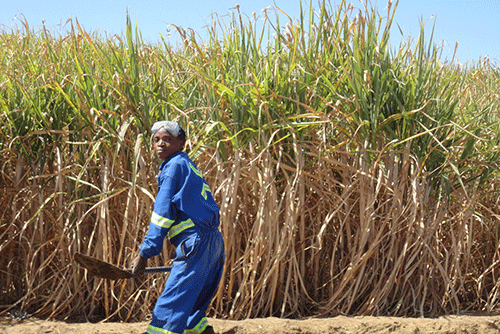KATIMA MULILO – Namibia is on an aggressive drive to establish a sugar plantation at Kalimbeza project in the Zambezi region to lessen the importation of sugar products from outside.
Namibia does not produce sugar. Therefore, its demand for sugar is fulfilled through importation mainly from South Africa, Eswatini, Zambia and Brazil, followed by the rest of the world.
Ministry of agriculture deputy director for public relations Chrispin Matongela revealed that Namibia’s quantity imported yearly averages
77 000 tonnes of sugar, which is valued at N$1 558 000 000.
During independence celebrations in March held in Zambezi, President Nangolo Mbumba informed that the government has provided N$8 million to revive the Kalimbeza Rice Project, and approved that a sugar plantation be established on the part of Kalimbeza, as well as a sugar-processing plant in Katima Mulilo.
In a recent interview with AgriToday, Matongela explained in depth what prompted the idea to set up a sugar plantation at Kalimbeza.
He highlighted the importance of local production and value-addition that this project could reap.
“During the Covid-19 outbreak, most countries had to rely on what they produce and/or store within their borders. There was a temporary shortage of food suppliers in most countries due to restrictions placed on the movements of goods and food supply chains. This experience has taught Namibia to move towards food self-sufficiency,” Matongela stated.
In addition, a huge import bill for any country affects the balance of payments (BoP) negatively, depriving the country of employment capital much-needed to fund development programmes and employment-creation efforts and diversification of agriculture production potential, including strategic crops like sugar cane.
He said unlocking and diversification of agriculture production potential, including strategic crops like sugar cane, is a key step to effecting import substitution, improving BoP, job- creation, value chain development and agro-business development within its borders.
“Namibia’s untapped potential for sugar production on arable land under irrigation presents an opportunity to increase local production at Kalimbeza, situated near the Zambezi perennial river, that will serve as a water source for irrigation.
“Agro-processing of locally- produced sugar will have a significant impact on reducing the importation of intermediate to finished products and incentivising animal feed production, as well as other industries that use the by-products of sugar processing. It is further important to note that sugar is an important production input in various food-based agro-industries such as confectionery, beverages and cereal-based products, among others,” he added.
Sugar is produced by planting sugar canes or sugar beets, which are processed into raw sugar and refined into sugar while producing many other important by-products.
Asked how much is budgeted for this plant to be set up, Matongela said the government plans to develop the land of 1 500 ha for sugar production at the Kalimbeza irrigation project, and 100 000 tonnes capacity of sugar -processing facility. He announced the development of land and procurement of machinery and equipment is estimated at N$240.3 million.
Land development includes boundary fencing, land clearing, bulk water infrastructure and installation of a centre pivot, while machinery and equipment include processing plants, tractors, cultivators, planters and harvesters.
Quizzed when the nation expects actual work such as feasibility studies to be carried out, Matongela said the sugar plantation and processing facility project in the Zambezi region was recently endorsed by Cabinet, and the feasibility study will commence in the 2024/25 financial year.
“The feasibility study will assess the project’s viability, and recommend hectares of land needed for the required production capacity,” he indicated.
Employment will be created variably for skilled and unskilled labourers during the development and operational phases of the project.
However, he assured the project will employ qualified Namibians (depending on the feasibility study), and as usual, further prioritise the employment of local youth in the Zambezi region during the development phase.
After the feasibility study, the project will move into design and documentation where the details relating to most of the activities and requirements will be determined with certainty.
Equally, seedlings will be procured according to set specifications through the public bidding process, depending on the availability, quality and market price of the seedlings.
“Seedlings could be sourced from the Zambezi region or neighbouring countries, or elsewhere in the world. All these details will be covered by the feasibility study,” he noted.
Asked if the sugarcane will be sold locally or to foreign markets, Matongela emphasised the priority is to satisfy the local demand for sugar before Namibia can export the surplus for foreign earnings.
“Sugarcane will be processed and packaged at the processing facility, and distributed locally. If there is a surplus, the country will consider exporting to other countries, and improve its trade balance for food importation,” he said.
-anakale@nepc.com.na



